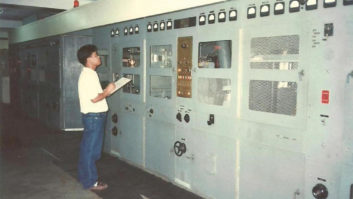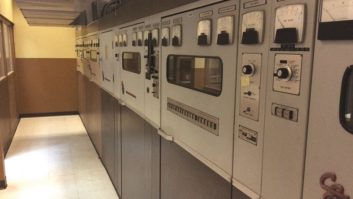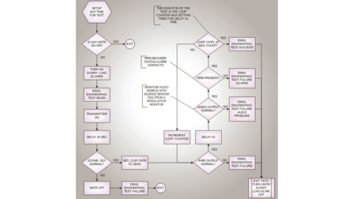(click thumbnail)Fig. 1: Add a box fan to improve dummy-load cooling.It won’t be long before transmitter buildings that lack air conditioning will turn into hot houses in many parts of the country, as higher daytime temperatures approach.
Faced with an older AM building with outside ventilation but no air conditioning, WILK(AM) Chief Engineer Ray Russ added a box fan to his 5 kW dummy load.
Fig. 1 shows the fan mounted below the load resistors, providing forced-air cooling and reducing transmitter building heat when the auxiliary is being tested. Five kilowatts of RF energy converted to heat is nothing to ignore. A side benefit is to increase the load efficiency by adding to the standard convection cooling. Similar cooling can be added to other equipment to improve airflow and efficiency.
Equipment racks can be installed with ready-made fan panels from Middle Atlantic to gain similar efficiencies. In fact, that manufacturer now has a new series of ultra-quiet fan panels, with two or four thermostatically controlled quiet fans, that provide cooling but minimize noise. Several models also provide a remote “overtemp” indicator, ideal for notification of a cooling issue before the equipment fails.
While we’re talking about cooling, don’t forget to add a spare fan for your FM exciter. Buy it now so it’s on the shelf; it’s cheap insurance. Most exciters won’t work long, if at all, after the fan gives out. A spare sitting on the shelf can minimize off-air time should the fan fail.
***
We’ve all dealt with the problem of drinks and food in the studio.
(click thumbnail)Fig. 2: A drink and snack caddy keeps refreshments outside the studio.
Here’s how Paul Shulins and his staff at Greater Media’s Boston cluster handle it. Seen in Fig. 2, a caddy located outside the door of each air studio offers plenty of room for snacks and drink cups or cans. The center hole leads to a trashcan hidden underneath and accessible by the front door.
By providing a place to store refreshments, the cluster has cut down on the problem of food and drink inside the studio on the console. The caddy also eliminates any excuse that there’s no place but the studio to store such items.
Fig. 3 shows a novel use of a D-ring, also found at Paul’s stations. The ring is just the right size for holding a spool of cross-connect wire, paying out as long a piece of wire as you need, without kinks or loops. I’ve seen this strategy using long bolts or screws, but the D-ring permits the spool to spin easily, so the wire can be pulled to any location on the punch block wall.
By the way, Paul Shulins will present a paper at this year’s NAB convention dealing with the issues of the 8-second HD radio delay. If you’ve converted to HD or plan to, his paper is a good tutorial of issues to expect, and how he and his team handled them.
***
(click thumbnail)Fig. 3: A D-ring efficiently holds a spool of cross-connect wire.
Frequent Workbench contributor Paul Sagi works in Malaysia but encounters many of the same problems that we have in the States.
Recently, he was repairing a piece of equipment and had to replace a wire because a heat-producing component near it had singed and dried out the insulation. The insulation was actually cracking and falling off. Usually, Paul covers the replacement wire with braided fiberglass sleeve.
Because of Murphy’s Law, the piece of sleeve on hand was too short; and it was a public holiday, so the stores were closed.
After digging around in his toolbox – and cranium – Paul decided to wrap the wire with several layers of Teflon pipe thread tape, also called “plumber’s sealing tape.” Teflon resists heat and chemicals and the tape is cheap. Several years later, back inside the same piece of equipment, Paul reports that the wire is still as good as new. The Teflon tape did a great job.
(click thumbnail)Fig. 4: A plastic bottle prevents arcing until a suitable replacement can be installed.
***
Speaking of engineering ingenuity, there’s such a thing as tower rigger ingenuity, too.
Faced with arcing to a tower leg from a skirt wire, one of our contributing contract engineers needed a standoff insulator. The tower rigger didn’t have an appropriate standoff insulator with him, or at least not a factory-made one. The engineer who sent Fig. 4 wasn’t sure of the breakdown voltage of an empty water bottle, but wondered if it would be higher if the paper label were removed!
The bottle stopped the arcing problem. Let’s just hope this doesn’t remain a permanent fix!
***
If you plan to attend the Dayton Hamfest, you might want to arrive a day early for Broadcasters General Store’s second annual equipment show.
Held on May 18 at the Dayton Mall Holiday Inn beginning at 8 a.m., the event is free, but registration is necessary. Contact Cecile Gibson at [email protected] for more information or to register.
















